Tom's Hardware Verdict
At $469.99, the ASRock Z690 PG Velocita sports capable power delivery, four M.2 sockets, Killer-based 2.5 GbE with Wi-Fi 6E, and an updated appearance. If you’re in the market for a sub-$500 board with PCIe 5.0 x4 M.2 and don’t mind running with the last generation audio codec, the Z690 PG Velocita is a solid option to build your system around.
Pros
- +
+ PCIe 5.0 M.2 socket
- +
+ 10 rear USB ports
- +
+ Active VRM cooling
- +
+ No Torx screws!
Cons
- -
Mediocre power delivery
- -
Last gen audio
Why you can trust Tom's Hardware
Full-featured motherboards based on the Intel Z690 chipset don’t come cheap, with some models costing more than $600. In this marketplace, ASRock’s $469 PG Velocita is a relatively-affordable option costing more than $100 less than the Z690 Taichi we reviewed previously and providing built-in Wi-Fi 6E, a PCIe 5.0 x4 M.2 socket and strong overclocking capability. However, stiff competition from other Z690 boards and a last-gen audio codec keep the PG Velocita from making our list of best motherboards.which. The Z690 version of the PG Velocita brings an updated appearance, improved power delivery, and an integrated PCIe 5.0 x4 M.2 socket. Like all of the other Z690-based boards we’ve tested, we again see more of an iterative update with the significant changes coming in the form of support for the new socket and all of the benefits Alder Lake brings to the table, including PCIe 5.0 functionality.
The Z690 PG Velocita tweaked its appearance over the Z590 version in a couple of ways, including a chipset heatsink redesign, some color swaps on the M.2 heatsinks, and a redesign of the IO cover. Overall, we feel it’s an improvement. The board also increased the M.2 socket count to four (from three), including one native PCIe 5.0 x4 (128 Gbps) socket, which we don’t see too much on Z690 boards. There are plenty of USB ports on the rear IO area; however, the only 20 Gbps port is on the front panel. ASRock even includes a GPU holder to support your heavy graphics cards.
Performance for the PG Velocita varied, but for the most part, it was average among the other DDR5 boards we’ve tested so far. Gaming performance was spot on, as was AIDA memory bandwidth testing. Power consumption was ever-so-slightly above average, not that you’d notice on your power bill. Overall, out-of-the-box performance is not a concern.
Specifications: ASRock Z690 PG Velocita
| Socket | Socket |
| Chipset | Z690 |
| Form Factor | 17 Phase (16+1 60A SPS MOSFETs for Vcore) |
| Video Ports | (1) HDMI (v2.1) |
| Row 4 - Cell 0 | (1) DisplayPort (v1.4) |
| USB Ports | (1) USB 3.2 Gen 2 Type-C (10 Gbps) |
| Row 6 - Cell 0 | (1) USB 3.2 Gen 2 (10 Gbps) |
| Row 7 - Cell 0 | (6) USB 3.2 Gen 1 (5 Gbps) |
| Row 8 - Cell 0 | (2) USB 2.0 (480 Mbps) |
| Network Jacks | (1) 2.5 GbE |
| Audio Jacks | (5) Analog + SPDIF |
| Legacy Ports/Jacks | ✗ |
| Other Ports/Jack | ✗ |
| PCIe x16 | (1) v5.0 (x16) |
| Row 14 - Cell 0 | (1) v4.0 (x4) |
| Row 15 - Cell 0 | (1) v3.0 (x2) |
| PCIe x8 | ✗ |
| PCIe x4 | ✗ |
| PCIe x1 | (2) v. 3.0 (x1) |
| CrossFire/SLI | Supports AMD CrossFire |
| DIMM slots | (4) DDR5 6400+(OC), 128GB Capacity |
| M.2 slots | (1) PCIe 5.0 x4 (128 Gbps) / PCIe (up to 80mm) |
| Row 22 - Cell 0 | (1) PCIe 4.0 x4 (64 Gbps) / PCIe (up to 80mm) |
| Row 23 - Cell 0 | (1) PCIe 4.0 x4 (64 Gbps) / PCIe (up to 110mm) |
| Row 24 - Cell 0 | (1) PCIe 3.0 x4 (32 Gbps) / PCIe + SATA (up to 80mm) |
| Row 25 - Cell 0 | Supports RAID 0/1/5 |
| U.2 Ports | ✗ |
| SATA Ports | (6) SATA3 6 Gbps (Supports RAID 0/1/5/10) |
| USB Headers | (1) USB v3.2 Gen 2x2, Type-C (20 Gbps) |
| Row 29 - Cell 0 | (2) USB v3.2 Gen 1 (5 Gbps) |
| Row 30 - Cell 0 | (1) USB v2.0 (480 Mbps) |
| Fan/Pump Headers | (8) 4-Pin (CPU, CPU/Water pump, Chassis/Water pump) |
| RGB Headers | (3) aRGB (3-pin) |
| Row 33 - Cell 0 | (1) RGB (4-pin) |
| Diagnostics Panel | 2-character debug LED |
| Internal Button/Switch | Power and Reset buttons, Clear CMOS switch |
| SATA Controllers | ✗ |
| Ethernet Controller(s) | (1) Killer E3100G (2.5 Gbps) |
| Wi-Fi / Bluetooth | Killer AX1675 Wi-Fi 6E (2x2 ax, MU-MIMO, 2.4/5/6 GHz, 160 MHz, BT 5.2) |
| USB Controllers | ASMedia ASM1074 |
| HD Audio Codec | Realtek ALC1220 |
| DDL/DTS Connect | ✗ / X |
| Warranty | 3 Years |
Inside the Box of the ASRock Z690 PG Velocita
Inside the box, ASRock includes in all the basic accessories you’d expect, including SATA cables, a Wi-Fi Antenna and a driver/support CD.. It also comes with a graphics cards holder that attaches to the board to support heavy video cards and a USB bracket for wireless dongles. Below is a complete list of the included extras.
- Quick Installation Guide, Support CD
- (4) SATA Data Cables
- Graphics Card Holder
- Wireless Dongle USB Bracket
- 3010 Cooling Fan with Bracket and Screw Package
- 4010 Cooling Fan Bracket and Screw Package
- (2) ASRock WiFi 2.4/5/6 GHz Antennas
- (3) x Screws for M.2 Sockets
- (3) Standoffs for M.2 Sockets
Design of the ASRock Z690 PG Velocita
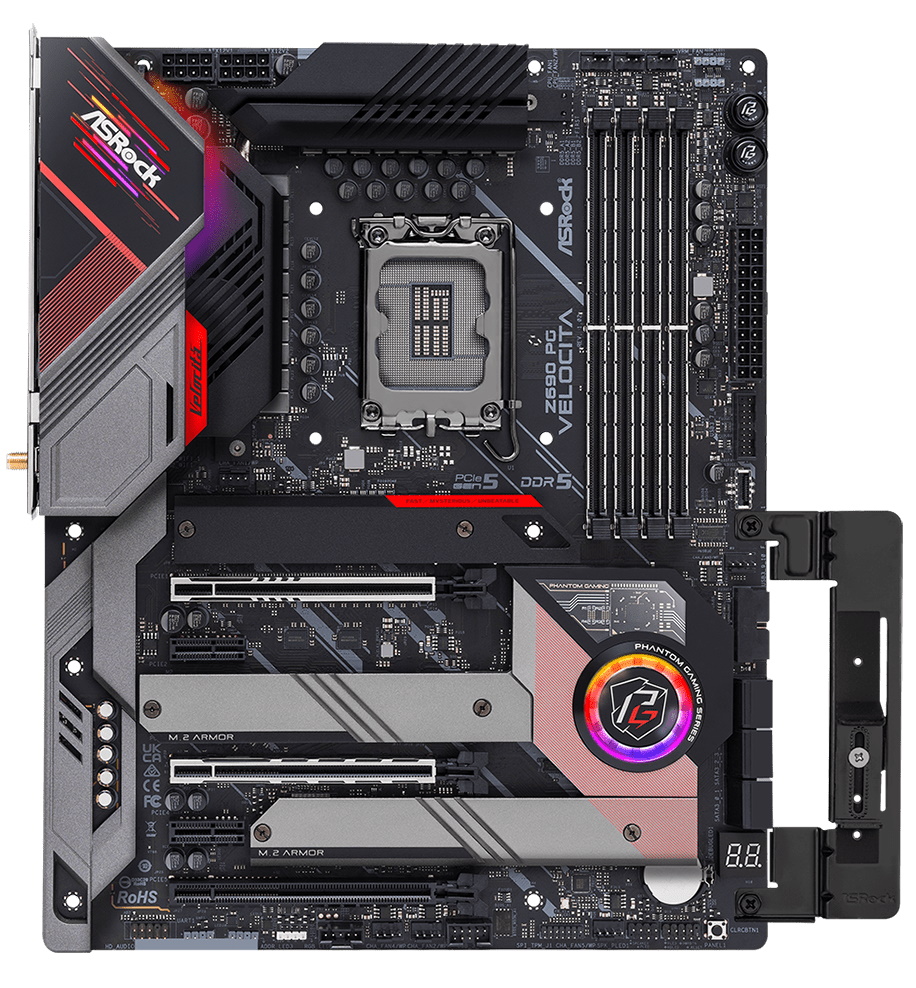
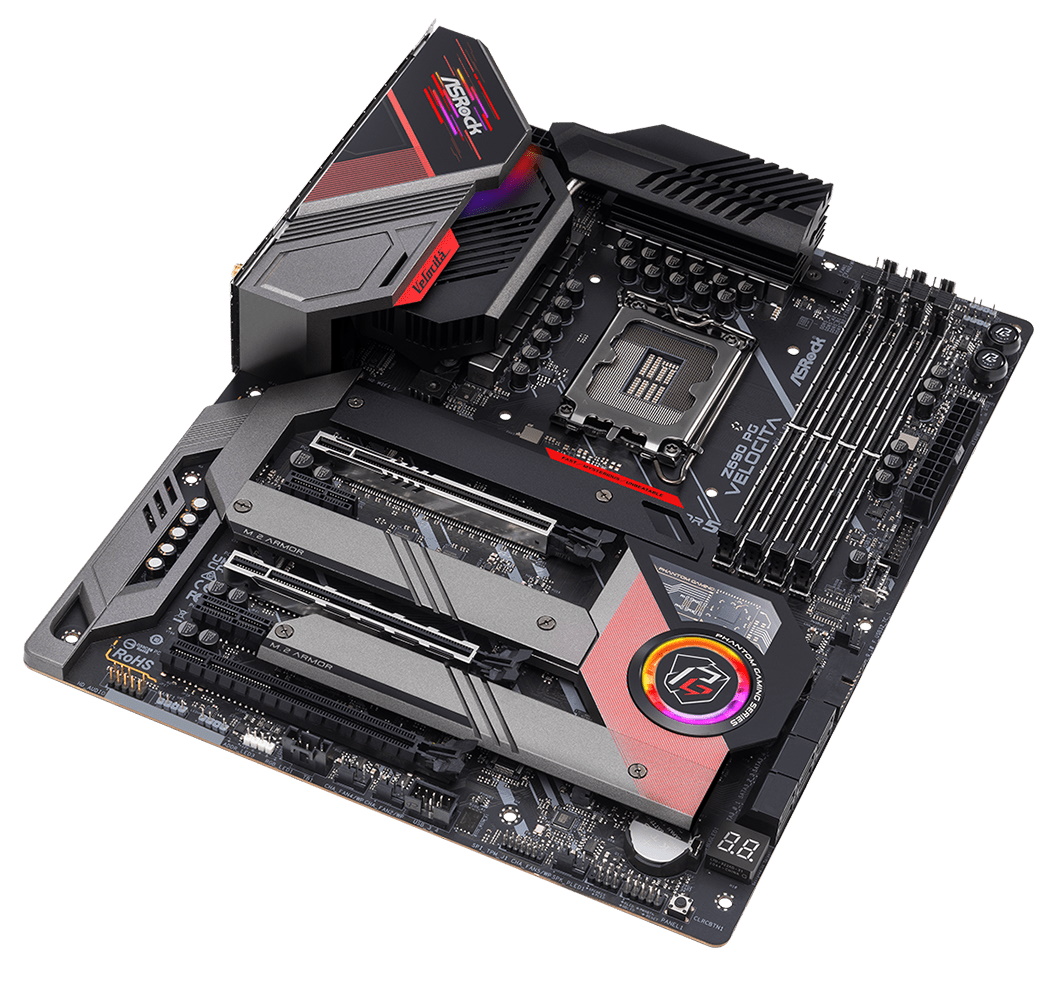
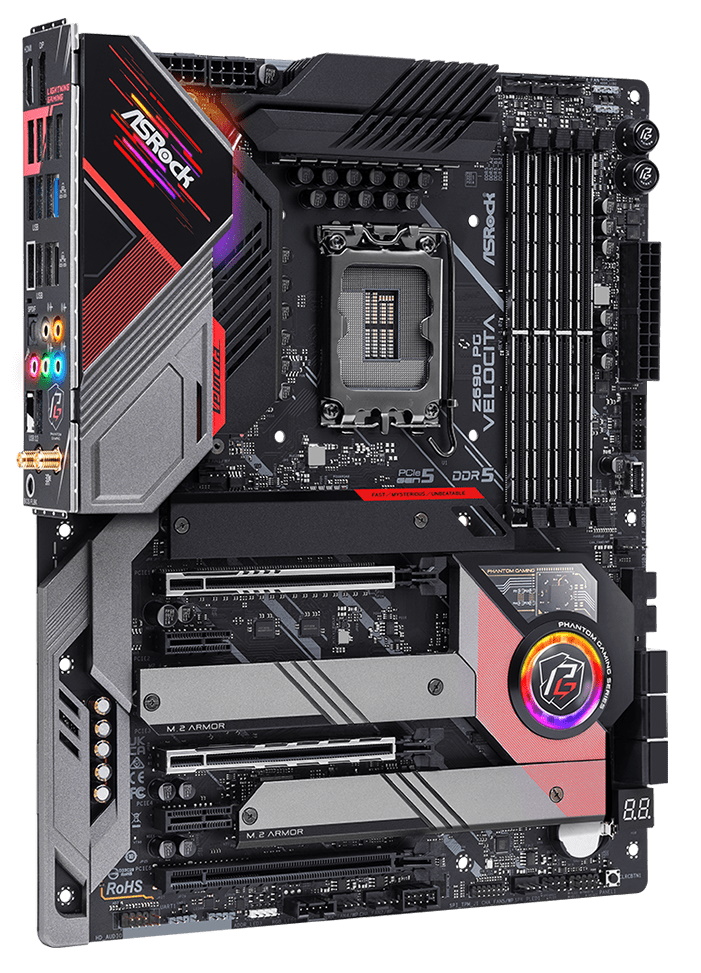
The Z690 PG Velocita is built with a black, eight-layer PCB. Over the rear IO area is a black and grey plastic shroud that partially covers the active VRM heatsinks. The first RGB element hides below this shroud and lights up the lines around the Chrome ASRock branding.
All of the M.2 sockets on the bottom half of the board get a heatsink as well. The chipset heatsink sports a unique circle design with RGBs and a see-through plexi part just above. Overall, the black and red appearance should match well with most build themes, but to me, it doesn’t quite give off the premium vibe some other boards in this class do.
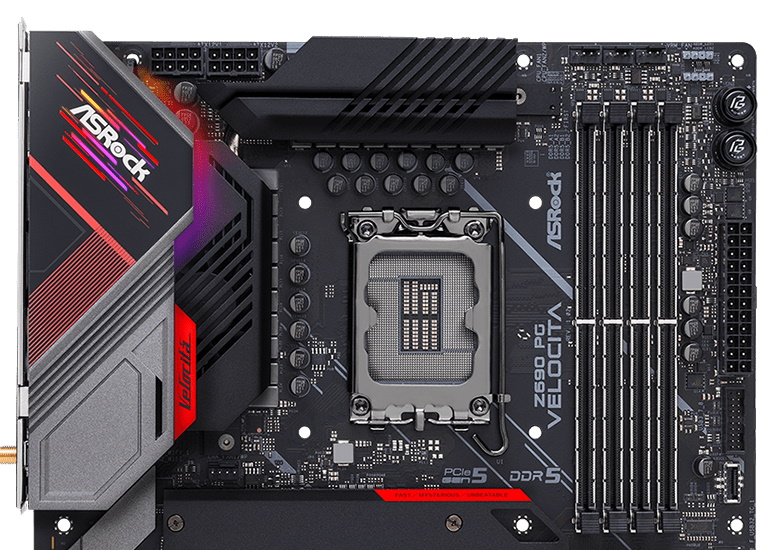
Focusing on the top half of the board, we get a better look at the VRM heatsinks, RAM sockets, and other connectivity in this area. Starting on the left, we already discussed the RGB lighting hidden below the shroud. It’s an accent and won’t take over the inside of your chassis, but the LEDs are saturated, producing nice color. The VRM heatsinks, while not as large as others, have active cooling on the left bank and a heat pipe that connects the two in order to share the thermal dissipation duties. Unlike with previous iterations, this fan started quiet and remained quiet throughout our testing. Two 8-pin EPS connectors provide power for the CPU.
Get Tom's Hardware's best news and in-depth reviews, straight to your inbox.
Continuing right, we run into the four reinforced DRAM sockets that support up to 128GB of DDR5. ASRock lists speeds up to DDR5 6400+, but your mileage may vary. In order to reach those speeds, you need an appropriate memory kit and a solid IMC on the processor (along with a BIOS that will do it).
Just above the DRAM slots are the first three (of eight) 4-pin fan headers. We have the CPU_FAN, CPU_FAN2/WP, and VRM_FAN headers in this area. The first CPU fan and VRM fan headers support 1A/12W of output, while the CPU_FAN2/WP header in the middle supports up to 3A/36W. The rest of the chassis fans output 1A/12W outside of the WP header (bottom edge) which is good for 2A/24W. There are plenty of headers and power for your fans and water pump.
To the right are the first RGB headers. Here we find two 3-pin ARGB headers, while on the bottom of the board is another 3-pin ARGB and a 4-pin RGB header. Control over the RGB lighting is handled by the ASRock Polychrome software, which worked fine in our limited testing.
Sliding around to the right edge, we run into the onboard power and reset buttons followed by the 24-pin ARX connector to power the board. The first USB 3.2 Gen1 (5 Gbps) header and a front-panel USB 3.2 Gen2x2 (20 Gbps) Type-C header are below that.

On the power delivery front, the Z690 PG Velocita got a slight upgrade from its Z590 counterpart. More power stages were added, and the VRM type was upgraded to SPS MOSFETs. Power comes from the 8-pin EPS connector(s) and onto a Renesas RAA229131 20-channel controller. Next, it goes to the 16 60A Intersil ISL99360 SPS MOSFETs. While the 960A available is incredibly low compared to similarly priced boards, it still handled our Intel i9-12900K processor at stock and while overclocked.
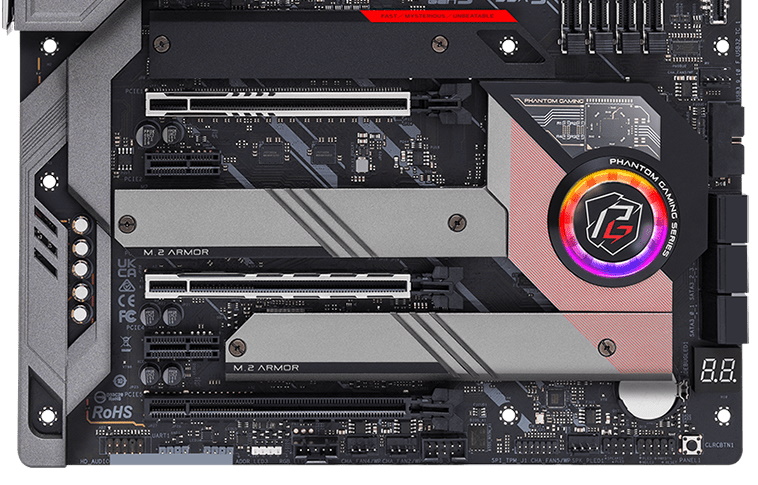
Moving down to the bottom of the board, we notice heatsinks covering all the important parts, but not much else. Starting on the left with audio, hidden below the plastic cover is the last generation flagship Realtek ALC 1220 codec and five dedicated audio capacitors. Most users will be happy with this solution, though other boards use the latest and greatest Realtek codec at the same price point. For the price, I would like to have seen the latest and greatest (ALC 408x) used here.
In the middle of the board, we find a few PCIe slots, along with four M.2 sockets sprinkled in among them. Starting with PCIe, there are four total slots--three full-length slots (top two are reinforced) and two open-ended x1 size slots. The top two full-length slots are wired for PCIe 5.0 and CPU-connected, while the bottom slot is PCIe 4.0 and fed from the chipset. The primary GPU slots run at x16/x0 or x8/x8, both PCIe 5.0. This configuration supports AMD Crossfire multi-GPU technology, but curiously (as it has the lanes/bandwidth), not Nvidia SLI. The x1 slots source their bandwidth from the chipset and run at PCIe 3.0 x1.
For M.2 connectivity, the Z690 Velocita has four sockets, an increase of one over the previous generation. The top socket, M2_1, supports PCIe 4.0 x4 modules up to 80mm, with M2_3 running the same speed and supporting the same PCIe protocol but supporting larger 110mm modules. M2_2 supports both SATA and PCIe drives with speeds up to PCIe 3.0 x4 (32 Gbps) and 80mm devices. M2_4 is your ‘Blazing’ PCIe 5.0 x4 (128 Gbps) socket. It supports PCIe modules up to 80mm. Note that the first PCIe socket downgrades to x8 mode with this socket occupied.
Moving right, we go past the uniquely designed chipset heatsink to the right edge. Here, we run into another USB 3.1 Gen 1 (5 Gbps) header and the six SATA ports. Also found in this area is the 2-character debug LED.
Across the bottom are several headers, including USB ports and RGB. Below is a complete list, from left to right:
- Front panel audio
- 4-pin UART header
- 3-pin ARGB header
- 4-pin RGB header
- Thunderbolt AIC header
- (2) System fan headers
- USB 2.0 header
- 2-character debug LED
- Front panel header
- Clear CMOS button
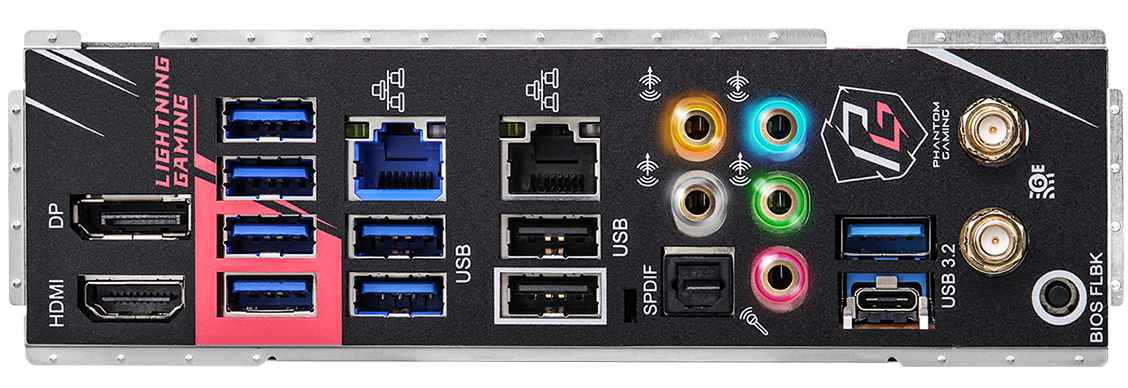
Swinging back to the critical rear IO area, we see a pre-installed IO plate matching the PG Velocita’s aesthetics. The black background gives way to red highlights and additional branding. The Lightning Gaming ports, which use two different controller interfaces that reduce latency and jitter for mice and keyboards, are labeled.
Hardware-wise, there are 10 total USB ports around back: two 10 Gbps ports (Type-C and Type-A), six 5 Gbps Type-A ports, and two USB 2.0 (480 Mbps) ports. The nine Type-A ports should be enough for most users. Also, on the rear IO, you’ll find a BIOS Flashback button, WI-Fi antenna connections, the Killer 2.5 GbE port (blue) and the Intel GbE port (black), along with HDMI (v2.1) and a DisplayPort (v1.4) output for video. The 5-plug analog ports on the audio stack light up, adding a bit of bling and perhaps helping you find the right plug a bit more easily.

Joe Shields is a staff writer at Tom’s Hardware. He reviews motherboards and PC components.
-
Starrbuck Just got one of these for $150. It's a bargain at that price compared to the release price!! Both LANs work fine on Linux.Reply